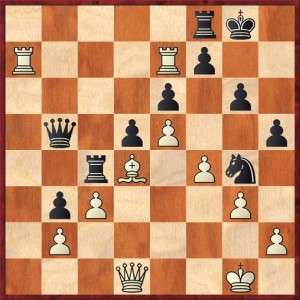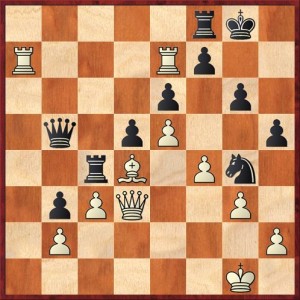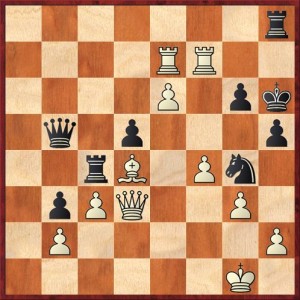Last weekend Mike Splane showed me a sensational game that he recently played at the Kolty Chess Club. It features a position where his opponent could have played a queen sacrifice, to which the best defense would have been a counter-queen sacrifice! The only slight blemish on the game is that Mike did not see his opponent’s threat. He was just lucky (sort of) that his own threat was faster. “Sometimes being a doofus is good!” he joked.
Let me back up to a move before the critical position. Black has just played 1. … Rc4, and it is now Mike’s move. (Unfortunately I don’t remember what his opponent’s name was.)
FEN: 5rk1/R3Rp2/4p1p1/1q1pP2p/2rB1Pn1/1pP3P1/1P5P/3Q2K1 w – – 0 2
It looks to me as if White can win a pawn in complete safety with 2. Reb7 Qc6 3. Rxb3. However, Mike thought he saw something better. And in fact he was right–it was better, only there was a little extra wrinkle that he hadn’t counted on.
The move he played was 2. Qd3!, which makes a drastic threat: 3. Qxg6+! forcing checkmate or winning a ton of material. What he hadn’t realized was that Black very nearly has a spectacular answer of his own.
FEN: 5rk1/R3Rp2/4p1p1/1q1pP2p/2rB1Pn1/1pPQ2P1/1P5P/6K1 b – – 0 2
I’m not quite sure how to caption this position. Black to play and almost draw? Black to play and scare the bejeezus out of his opponent? Anyway, can you see what Black’s idea was?
The answer is that Black can almost play 2. … Rxd4!?, simultaneously offering a queen sacrifice and an exchange sac. White is ill-advised to accept either. If 3. Qxd4 then 3. … Qe2 is winning for Black — not only because of the danger of … Qxh2+ but also because the b2 pawn is hanging. And if 3. Qxb6 Black has a remarkable drawing variation: 3. … Rd1+ 4. Kg2 Rd2+ 5. Kf1 (if the king goes to either f3 or h3 he gets mated!) 5. … Nxh2+ with a perpetual check. This is a great position to know, and in fact I mentioned it in my recent post Questioning Assumptions: rook and knight against a king on the edge of the board can often draw all by themselves.
As it turns out, White actually does have a way to thwart this combination. After taking the queen with 3. Qxb5 Rd1+ he can give it right back with 4. Qf1! Then Black’s best move is 4. … Ne3!, leading more or less by force to the following line: 5. Qxd1 Nxd1 6. Rab7 Nxb2 7. Rxb3 Nc4. (Diagram)
FEN:5rk1/4Rp2/4p1p1/3pP2p/2n2P2/1RP3P1/7P/6K1 w – – 0 8
This is actually a pretty interesting endgame position in its own right. Mike thought that Black might actually have a “fortress,” but I don’t think so. To create a fortress, Black really needs his knight to be on e4, but if he goes there the knight will be subject to undermining with c3-c4. Still, it will be a long and agonizing struggle for White to win this game.
But anyway, this is all moot, because in diagram 2, after 2. … Rxd4!? White would play 3. Qxg6+!! and win. That’s what I started this post with–defending against a queen sacrifice by a counter-queen sacrifice. Note also that if Black declines with 3. … Kh8 White continues 4. Qxh5+ Kg7 5. Qxg4+, getting rid of the knight, after which he can take on d4 without any fear of getting checkmated.
Black saw this, and instead of the failed brilliancy of 2. … Rxd4, he played 2. … Kg7 to defend his g-pawn. But now his kingside collapses around him. 3. Rxe6! takes advantage of the pin on f7 and threatens Qxg6+, so Black still doesn’t have a chance to play his queen sac. Black defended with 3. … Kh6 and now Mike offered a rook sacrifice with 4. Rxf7! Once again this forestalls Black’s dreams of sacrificing his queen, because mate is threatened on g6. Black continued playing forced defensive moves: 4. … Rg8 5. Ree7 Rh8 6. e6! (diagram)
FEN:7r/4RR2/4P1pk/1q1p3p/2rB1Pn1/1pPQ2P1/1P5P/6K1 b – – 0 6
With threats like Bg7+ and Bxh8 in the air, it’s all over. I’m not sure whether Mike’s opponent played on a couple more moves or resigned here, but in any event the result was 1-0.
A pretty cool finish! I have one remaining challenge for the reader: Can any of you find an actual tournament game where one side plays a queen sacrifice, and the only way for the other player to avoid defeat is to play an immediate counter-queen sacrifice that wins? I’m sure that it must have been done, but I can’t think of one off the top of my head. This position is not quite an example because Mike’s queen sac idea 3. Qxg6+ avoids a draw, not a defeat; and maybe he could have won anyway with the 5. Qf1 idea that led to diagram 3.







{ 2 comments… read them below or add one }
Just to clarify a few points:
The game was played at the Kolty chess club on May 9, 2013. The player with the Black pieces was Alok Singh, rated 1875.
I did see the rook sacrifice on d4. The only reason I was considering 1. Qd3 as a candidate move was to pin the rook to prevent the sacrifice. I was only looking at it as a potential defensive move at first, then I suddenly saw the Qg6++ threat. That’s what I meant by my joke about being a doofus. I lucked into a mating threat.
My second error in calculation was that I stopped calculating what would happen after 1. Qd3 Rd4 2. Qxb5 Rd1+ 3. Kg2. I missed was the follow up perpetual check idea of 3 … Rd2+.
My third error in calculation was after 1. Qd3 Rxd4 2. Qxb5 Rd1+ 3. Qf1 I also stopped calculating. I missed the strong move 3 … Ne3, winning the b2 pawn. I assumed he would have to play 3 … Rf1+ 4. Kf1 Nh2+ which is not dangerous, White wins the b3 pawn and the passed pawn on b will be enough to win the game.
I agree with Dana’s assessment that Black does not have a fortress draw in the third diagram, even if he could get the knight to f5 or d8.
Two more moves were played from the final diagram; 6… Qa6 and 7. Bg7+. The queen finally gets to mate on g6 after the forced 7 … Kh7 8. Bf8+Kg8 so Black resigned.
Hi Mike, Thanks as usual for explaining! I did kind of misunderstand the doofus comment, which makes even more sense now that I understand what the “lucky” part was.
{ 1 trackback }